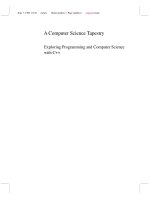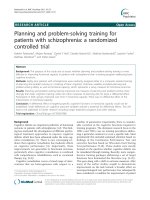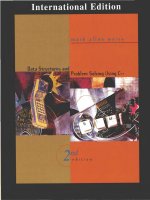programming and problem solving with c++ 6th by dale ch1
Bạn đang xem bản rút gọn của tài liệu. Xem và tải ngay bản đầy đủ của tài liệu tại đây (449.05 KB, 44 trang )
Chapter 1
Overview of Programming
and Problem Solving
Slides based on work by Sylvia
Sorkin, Community College of
Baltimore County - Essex
Campus
Chapter 1 Topics
●
●
●
●
●
●
●
●
●
●
Computer Programming
Programming Life-Cycle Phases
Creating an Algorithm
Machine Language vs. Assembly Language vs.
High Level Languages
Compilation and Execution Processes
C++ History
Basic Control Structures
Computer Components
Computing Profession Ethics
Problem-Solving Techniques
What is Computer Programming?
●
It is the process of planning a
sequence of steps(called
instructions) for a computer to
follow.
STEP 1
STEP 2
STEP 3
. . .
Programming Life Cycle Phases
• Problem-Solving
• Implementation
• Maintenance
Problem-Solving Phase
●
Analyze the problem and specify what the solution must do
●
Develop a general solution(algorithm) to solve the problem
●
Verify that your solution really solves the problem
Sample Problem
Suppose a programmer needs to determine an employee’s weekly
wages.
How would the calculations be done by hand?
One Employee’s Wages
In one week an employee works 52
hours at the hourly pay rate of $24.75.
Assume a 40.0 hour normal work
week and an overtime pay rate factor
of 1.5.
What are the employee’s wages?
40 x $ 24.75
=
12 x 1.5 x $ 24.75=
$990.00
$445.50
___________
$
1435.50
Weekly Wages, in General
If hours are more than 40.0
wages =
(40.0 * payRate) +
(hours - 40.0) * 1.5 *payRate
RECALL EXAMPLE
otherwise
(40 x
$ 24.75) +(12 x 1.5 x $ 24.75) = $1435.50
wages = hours * payRate
An Algorithm
●
An algorithm is a step-by-step procedure for solving a problem
■
with a finite amount of data
■
in a finite amount of time
Algorithm to Determine an
Employee’s Weekly Wages
1.
2.
3.
4.
5.
Get the employee’s hourly payRate
Get the hours worked this week
Calculate this week’s regular wages
Calculate this week’s overtime wages(if any)
Add the regular wages to overtime wages(if any)
to determine total wages for the week
What is a
Programming Language?
●
A programming language is a language with strict grammar
rules, symbols, and special words used to construct a computer
program
Implementation Phase:
Program
●
●
Translating your algorithm into a programming language is
called coding
With C++, you use
Documentation -- your written comments
Compiler -- translates your program
into machine language
Main Program -- may call subalgorithms
Implementation Phase: Test
●
Testing your program means
running(executing) your program on
the computer, to see if it produces
correct results
●
If it does not, then you must find out
what is wrong with your program or
algorithm and fix it--this is called
debugging
Maintenance Phase
●
Use and modify the program to meet changing requirements or
correct errors that show up in using it
●
Maintenance begins when your program is put into use and
accounts for the majority of effort on most programs
●
Wholly rewriting program with a clear design sometimes a useful
alternative to modifying the existing program to meet changing
requirements
Software Maintenance Tips
●
●
●
●
Check the existing code works as
claimed
Make changes to a copy of the existing
code
After acheiving desired functionality,
change related aspects of the program
to leave clean, consistent code for the
next programmer
Keep backup copies of current version
of code to assist in developing new
programs
Programming Life Cycle
1 Problem-Solving Phase
Analysis and Specification
General Solution(Algorithm)
Verify
2 Implementation Phase
Concrete Solution(Program)
Test
3 Maintenance Phase
Use
Maintain
A Tempting Shortcut?
DEBUG
REVISE
REVISE
DEBUG
Sh
t?
u
c
ort
DEBUG
REVISE
CODE
GOAL
TEST
THINKING
CODE
Levels of Abstraction
Natural language
(English, French, …)
High-level language
(C++, java, Visual Basic, ..)
Low-level language
(Assembly language)
Machine language
Memory Organization
●
Two circuit states correspond to
●
Bit(short for binary digit) refers to a
single 0 or 1
Bit patterns represent both the computer
instructions and computer data
●
●
1 byte
=
8 bits
●
1 KB
=
1024 bytes
●
1 MB
=
1024 x 1024
0 and 1
= 1,048,576 bytes
How Many Possible Digits?
●
Binary(base 2) numbers use 2
digits:
just 0 and
1
●
Decimal(base 10) numbers use 10
digits:
0 through 9
Machine Language
●
Is not portable
●
Runs only on a specific type of
computer
●
Is made up of binary-coded
instructions(strings of 0s and 1s)
●
Is the language that can be directly
used by the computer
Assembly Language
●
●
●
●
An programming upgrade from
machine language
Instructions for program are in a
mnemonic
Computer cannot directly execute
the instructions
An assembler program translates
the assembly language instructions
into machine binary code
High Level Languages
• Portable
• User writes program in language similar
●
●
to natural language such as English
Many use a compiler to translate
programs written in certain high-level
languages
Examples --
FORTRAN, COBOL, Pascal,
Ada, Modula-2, C++,
Java
●
Most are standardized by ISO/ANSI to
provide an official description of the
language
Three C++ Program Stages
myprog.cpp
myprog.obj
myprog.exe
SOURCE
OBJECT
EXECUTABLE
written
written in
in
C++
C++
written
written in
in
machine
machine
language
language
via compiler
written
written in
in
machine
machine
language
language
via linker
other
other code
code
from
from libraries,
libraries,
etc.
etc.
Java Programming Language
●
Achieves portability by using both a
compiler and an interpreter
●
First, a Java compiler translates a Java
program into an intermediate Bytecode--not
machine language
●
Then, an interpreter program called the Java
Virtual Machine(JVM) translates a single
instruction in the bytecode program to
machine language and immediately runs it,
one at a time









